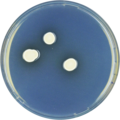| Aspergillus aurantiobrunneus | |
|---|---|
| Scientific classification | |
| Kingdom: | Fungi |
| Division: | Ascomycota |
| Class: | Eurotiomycetes |
| Order: | Eurotiales |
| Family: | Aspergillaceae |
| Genus: | Aspergillus |
| Species: | A. aurantiobrunneus |
| Binomial name | |
| Aspergillus aurantiobrunneus (G.A. Atkins, Hindson & A.B. Russell) Raper & Fennell (1965) [1] | |
Aspergillus aurantiobrunneus is a species of fungus in the genus Aspergillus . It is from the Nidulantes section. [2] The species was first described in 1965. [1] It has been reported to produce emeremophiline, emericolin A-D, variecolin, variecolol, desferritriacetylfusigen, sterigmatocystin, variecoacetals A and B, variecolactone, and variecolin. [2]

